Advertisement
Advertisement
 Kaze Fresh Japanese Restaurant
Kaze Fresh Japanese Restaurant The buzz: Situated in the Thonglor neighborhood this stylish restaurant is perfect if you’re in the mood for a classic sushi bar menu and vibe. Despite the lack of fusion food, Kaze isn’t boring, thanks to décor that’s fit for a Thonglorite.
The décor: A mix of marble and wood, a painting of Koi carp, warm lights and two floors to choose from: the sushi bar where the chef shows off his skills and the dining room upstairs.
The food: The highlights are the light battered tempura moriawase (prawns and vegetable, B360), or opt for the set of nine bites comprising fish like otoro, anago, engawa and uni (B3,200). The restaurant uses beef sourced from Kagishima (B450), said to be tastier than the more commonly found wagyu. If you’re still hungry, indulge in some rice topped with foie gras (B550).
The drinks: A standard selection of sake starts from B130 with the recommendations including Ozeki Karatanba (B4,000 for 1.8 liter).
The crowd: A mix of trendy Thais and Japanese expats.
318 Sukhumvit 55 (between Thonglor Soi 10 and 12), 02-392-3544. Open daily noon-2pm, 5-10:30pm
 Sen-ryo
Sen-ryoThe buzz: Sen-ryo imports everything from Japan; from its chef to the crockery, and of course nearly every ingredient used to create the traditional dishes on its menu. The attention to detail extends to the water they use to clean the fish and cook their rice, which is cleaned through reverse osmosis. The first Sen-ryo outside of Japan was in Hong Kong and it’s a pretty big deal out there, with customers lining up for lunch.
The décor: Simple, elegant sofa seating along the conveyor belt and the requisite light-colored wooden furnishings. Private rooms are also available.
The food: Mainly classic sushi dishes. Plates placed on the conveyor belt have a chip attached to them to ensure freshness by getting automatically removed from the belt after a certain amount of time. Recommended dishes include the fresh kama toro sushi (tuna cheeks, B350), salmon roe sushi (B280), wagyu beef (B480) and incredibly creamy sea urchin (B780).
The drinks: Sake starts at B240/glass and beers include Asahi Draft (B75), Singha (B125) and Heineken (B90).
The crowd: Mainly Japanese expats from the area.
RG01, Nihonmura Mall, 85 Thonglor Soi 13, 02-712-9688. Open daily 11:30am-2pm and 6-10pm
 Kaguya
KaguyaThe buzz: Set on the corner of Thonglor Soi 10, Kaguya serves a mix of contemporary Japanese and French cuisine under the same management team as its next door neighbor, Wine Republic. The hip young crowds should dig the DJ, lengthy cocktail list and one of the most stylish decors on the strip.
The décor: A layered series of screens, from bamboo strips to rods tied into narrow scaffolding, filter warm light through their golden, natural colors. Choose from bar seating under the glowing yellow cloud of light, outdoor sofas, or the vividly colored dining room’s orange and sea green chairs.
The food: Start off with an aromatic, velvety vanilla soup with seared scallop (B200) followed by red mullet with black olive and lemon (B320) and 56-hour sous-vide wagyu tongue with soy sauce, rosemary and thyme (B420). Aside from the sashimi and sushi bar, Kaguya serves main dishes like grilled king crab’s leg with sautéed mushroom and caramelized leek puree (B1,300) or lamb rack marinated in herbal miso, rosemary foam, kimchi mashed potato and mint ponzu (B1,000).
The drinks: This place takes its drinks very seriously. Cocktails include Gentleman’s Truth (Tanquery gin, Violet, herbal liqueur, citrus, oregano, B320) and the bartender’s own creation’s, such as Panna (Gold Label, Fireball cinnamon whiskey, honey, pineapple juice, B280). Beers include Hoegaarden (B160), Norrebro (B280), Mikkeller (B280) among others. They also have an impressive list of Japanese spirits categorized by taste such as woody, mellow, fruity, peaty and floral from B220-900.
The crowd: Groups of hip and well-heeled Thonglorites.
The Third Place, 137 Thonglor Soi 10, 02-714-9974. Open Mon-Fri 5:30pm-1am and Sat-Sun 11am-2pm, 5:30pm-1am
 Sushi Planet
Sushi PlanetThe buzz: From California to Bangkok, the chain restaurant Sushi Planet has landed in Bangkok, where it serves up its signature fusion rolls from the original venues with tweaks designed to better suit the Thai palate.
The décor: Casual and simple with TV screens tuned to football emphasizing the laid-back atmosphere.
The food: Contemporary rolls which use lots of spicy mayo, jalapeno and avocado. The recommendations include Oh My God (rolls with spicy shrimp salad, shrimp tempura, salmon and avocado on top, B395) and Big Boss (rolls with shrimp tempura, crab salad and cucumber inside with seared tuna and fried red onion with spicy karashi sauce, B375). You can also sample some light appetizers such as the Japanese ceviche (B355) or drop by on the lunchtime for lunch sets ranging from B195-B290.
The drinks: Asahi draft beer is B99. The Ozeki hot sake is B249 and Berry Mix Sparkling Jelly sake is B250. A selection of wine starts from B120 by glass.
The crowd: The majority of the customers are Western expats and families from the ‘hood.
Athenee Residence, Soi Ruamrudee, BTS Ploen Chit, 02-168-5214. Open daily 11am-10pm
 Kokoro Hello Japanese
Kokoro Hello Japanese The buzz: Located in the community mall Rainhill, Kokoro promises a traditional cooking style led by Japanese Chef Mi Chan whose experience spans over four decades.
The décor: Warm and sophisticated, with views over Sukhumvit, the restaurant is divided between a sushi and cocktail bar at the front, and private rooms decorated with traditional paintings out back.
The food: Besides classic dishes like otoro sushi (B690), uni sushi (B469) and buri kama shioyaki (grilled salted yellowtail cheek, B1,090), the place also recommends their deep broth shabu (B690) for a smooth addition to your meal. You could also opt for the sashimi set (B1,490). And don’t leave without trying the delicious coffee jelly (B100).
The drink: Sake ranges from B320 to B1,800. Beers covers everything from Singha (B80) and Heineken (B90) to Federbrau light (B140).
The crowd: Thai families and groups of friends seeking convenience and tradition rolled into one sushi joint.
3/F, Rain Hill, Sukhumvit Soi 47, 02-261-7539-40. BTS Phrom Phong/Thong Lo. Open daily 11:30am-10pm
Advertisement
How did Thai Community Lacrosse begin?
In 2011, I was sitting at a coffee shop with my friends. We’d just got back from the States after living there for more than 10 years. We’d played lacrosse there and we talked about bringing it to Thailand. So we set up TCL, an independent non-profit organization to teach lacrosse to slum kids and help them through sport.
What kind of kids are in the program?
Many of them used to sniff glue and some of them used to be in drug gangs. The kids are controlled by the drug dealers who transport the drugs around the slum through the kids.
You must have come across some bad cases?
Yes there is a situation with one fourth grader who used to play with us. His parents are drug addicts and have spent time in jail. One day, he didn’t show up to practice and we found that the reason was his mom had gotten him out of school and forced him to work so she can buy more drugs. We try to help him but it’s a family matter. At the end of the day, this kind of problem is beyond our reach. The school talks to the parents of the kids and suggests our lacrosse program as an after-school activity, but when they get home, it’s a family affair.
What is the toughest challenge teaching these kids?
To make them trust us. The kids have so many random people giving them free stuff at school [as charity] and they never come back. I think they feel unwanted a lot of times. People come and try to be their friends but then they go and they never get to see them again. We tried to gain their trust by practicing three times a week in the first year. We wanted to make them feel like we are always there.
How do you keep in touch with the kids after they leave the lacrosse club?
There are two ways to track the kids. The first is through the school, however we are also trying to develop an alumni of all the previous lacrosse players. Every year, I set up an event for the kids to come and play lacrosse together. Some of them continue their studies while some kids have to work for a living. It’s really up to the kids whether they use the experiences they get from us to change their lives. Many have decided not to get involved with the gangs and have turned into good citizens.
Thai Community Lacrosse, www.tclacrosse.com, 02-348-8379
Advertisement
Advertisement
Advertisement
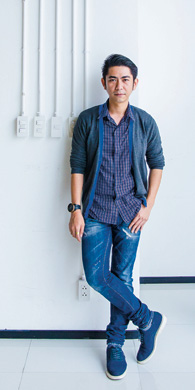
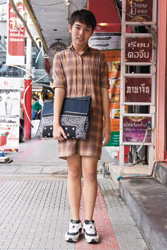 |
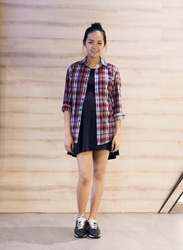 |
|
It, 19, fashion student
Jumpsuit: Playhound
Clutch: JJ Market
Shoes: Chane
|
Siri Sirisubjanan, 23, freelance
Top: Uniqlo
Dress: H&M
Shoes: Nike
|
"Compared to the street fashion of my generation, where everybody wore Thai designer brands, the trend is shifting towards the high-street."
Advertisement
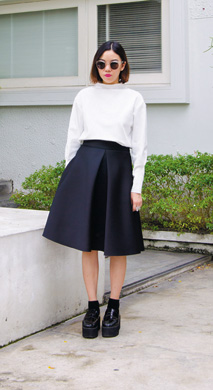
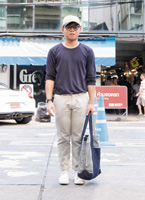 |
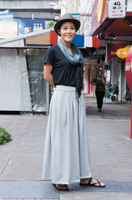 |
|
Boripat Singkaew, 23, graphic designer and illustrator
Hat: Siam
Top: Uniquo
Bottoms: Muji
Bag: Siam
Shoes: Converse
|
Nadda Kank, 32, advertising freelance
Top: Zara
Skirt: Siam Street shops
Sandals: Siam Street shops
Hat: Jatujak Market
|
"Young Thai people tend to follow celebrities. I think it would be more fun for people to explore new styles from those who really embrace different tastes."
Advertisement
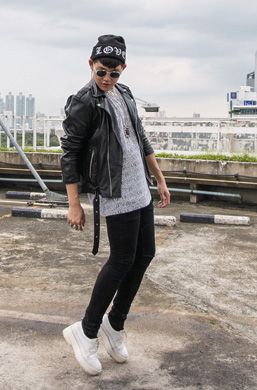
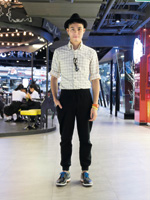 |
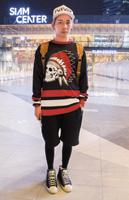 |
|
Tada, 25, stylist and designer
Top: Tommy Hilfiger
Bottoms: H&M
Shoes: H&M
|
BND, 23, designer of Fuxury |
"Dressing up is all about being brave as an expression of one’s self."
Advertisement
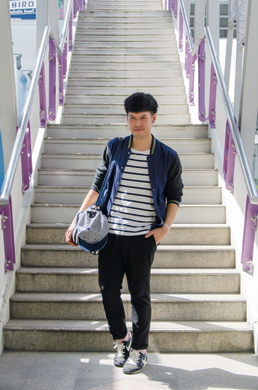
Supakasem “Mile” Chanapas, 25,
fashion stylist at L’Officiel Thailand
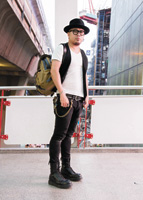 |
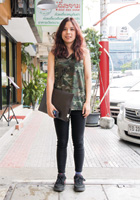 |
|
Max, 42, hairdresser
Cap: NYA
Top: Chaps
Bottoms: Chaps
Shoes: DM
|
Suthatip Air, 24, student
Top: Union Mall
|
"Thai people are more expressive than ever before: they have their own sense of style and are not afraid to be different."
Advertisement
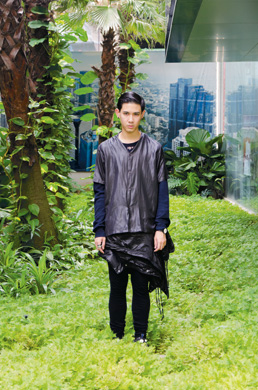
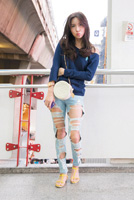 |
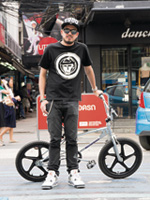 |
|
Best Jareonthamasuk, 23, makeup artist
Top: Yeti Shop
Bottoms: DIY by Bset
Shoes: Milin
Bag: Aristotle
|
Knatz, DJ,
Cap: Stussy
Top: Chap Man
Bottom: APC
Shoes: Jordan
|
Advertisement